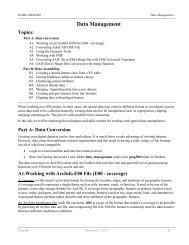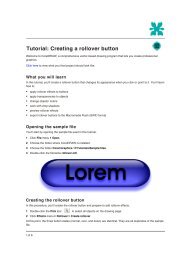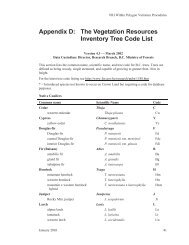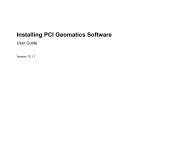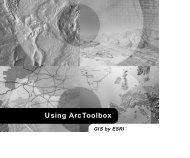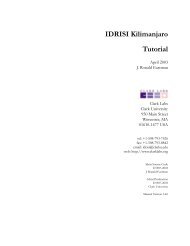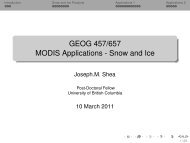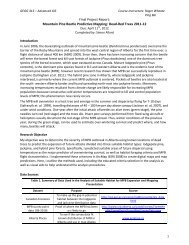Understanding Map Projections
Understanding Map Projections
Understanding Map Projections
You also want an ePaper? Increase the reach of your titles
YUMPU automatically turns print PDFs into web optimized ePapers that Google loves.
SPHEROIDS AND SPHERES<br />
The shape and size of a geographic coordinate<br />
system’s surface is defined by a sphere or spheroid.<br />
Although the earth is best represented by a spheroid,<br />
the earth is sometimes treated as a sphere to make<br />
mathematical calculations easier. The assumption<br />
that the earth is a sphere is possible for small-scale<br />
maps (smaller than 1:5,000,000). At this scale, the<br />
difference between a sphere and a spheroid is not<br />
detectable on a map. However, to maintain accuracy<br />
for larger-scale maps (scales of 1:1,000,000 or larger),<br />
a spheroid is necessary to represent the shape of the<br />
earth. Between those scales, choosing to use a<br />
sphere or spheroid will depend on the map’s<br />
purpose and the accuracy of the data.<br />
A sphere is based on a circle, while a spheroid (or<br />
ellipsoid) is based on an ellipse. The shape of an<br />
ellipse is defined by two radii. The longer radius is<br />
called the semimajor axis, and the shorter radius is<br />
called the semiminor axis.<br />
The semimajor axis and semiminor axis of a spheroid.<br />
A spheroid is defined by either the semimajor axis,<br />
a, and the semiminor axis, b, or by a and the<br />
flattening. The flattening is the difference in length<br />
between the two axes expressed as a fraction or a<br />
decimal. The flattening, f, is:<br />
f = (a - b) / a<br />
The flattening is a small value, so usually the<br />
quantity 1/f is used instead. The spheroid parameters<br />
for the World Geodetic System of 1984 (WGS 1984 or<br />
WGS84) are:<br />
a = 6378137.0 meters<br />
1/f = 298.257223563<br />
The flattening ranges from zero to one. A flattening<br />
value of zero means the two axes are equal,<br />
resulting in a sphere. The flattening of the earth is<br />
approximately 0.003353.<br />
Another quantity, that, like the flattening, describes<br />
the shape of a spheroid, is the square of the<br />
eccentricity, e 2 . It is represented by:<br />
The major and minor axes of an ellipse.<br />
Rotating the ellipse around the semiminor axis<br />
creates a spheroid. A spheroid is also known as an<br />
oblate ellipsoid of revolution.<br />
2<br />
e =<br />
2 2<br />
a − b<br />
2<br />
a<br />
DEFINING DIFFERENT SPHEROIDS FOR<br />
ACCURATE MAPPING<br />
The earth has been surveyed many times to help us<br />
better understand its surface features and their<br />
peculiar irregularities. The surveys have resulted in<br />
many spheroids that represent the earth. Generally, a<br />
4 • <strong>Understanding</strong> <strong>Map</strong> <strong>Projections</strong>




